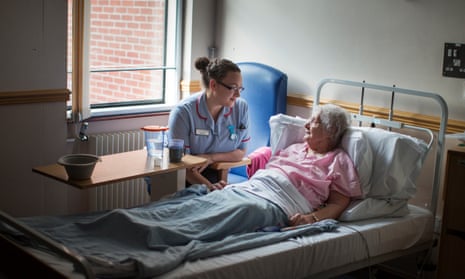Reginald Brown, 86, is sitting beside his hospital bed with his bags packed. “You can talk to me, but I’m about to go home,” he says happily.
Brown has lived alone without care assistance since his wife died three years ago. He is cheerful, engaging and – until recently at least – a “bed-blocker”. Understandably, the offensive term does not sit well with him.
“No. I was only in here a few days,” he says.
Brown was admitted to Ipswich hospital on New Year’s Eve following a fall. After a few days of treatment he was declared fit to be discharged, but because of the time of year, it took three days for the hospital to find him a carer who could carry out the twice-daily visits that would allow him to return home safely.
So for three days Brown was, in NHS parlance, a “delayed transfer of care” or, in colloquial terms, a bed-blocker.
“It was just the backlog of Christmas and new year, there were lots of potential people who needed care,” says Brown’s daughter, Jan Watling. “If you’re going to fall, pick your time.”
Brown’s situation – awaiting a care package in his own home – is fairly typical of the reason for a delayed transfer of care. Sadly, the speed with which care was organised for Brown is atypical of the experience of many elderly patients. People can wait weeks, or even months, for care to be arranged and so take up semi-permanent residency in a hospital ward.
The number of bed days lost in England to bed-blockers in November 2015, the last month for which data is available, was 153,191. The number for October 2015 was a record 160,094.
Some regions suffer more than others, with the Midlands and south-west particularly badly affected. There are many causes, including poor communication between departments and delays in getting a patient’s discharge signed off. The most common reason cited was that a patient was awaiting further non-acute NHS care, including intermediate care and rehabilitation services, which accounted for 20.1% of all bed days lost in 2014-15.
Social care issues are an increasing problem, and given the significant cuts to social care funding, £1.7bn since 2010, it looks likely to get worse.
‘The system needs a fundamental rethink’
The statistics on delayed transfers of care reveal a health service with significant blockages, but in reality there are even more delays than these numbers indicate.
“Delayed transfers of care are only one sign of the problems we have in moving patients to the right place quickly and smoothly enough,” said Nigel Edwards, chief executive of the Nuffield Trust.
“A small number of patients accounts for a large proportion of NHS bed use, which is under great pressure after years of reducing available space,” he said. “These patients require complex help, and some are still very unwell. Many might do better with NHS or social care treatment at home or in smaller facilities. But with cuts to social care and limited growth in community NHS care, too often this isn’t an option.”
May Gurney, 97, is an example of someone who would, with better funded social services, prefer to complete her recovery back in her nursing home in Stowupland. “The carers are wonderful,” she says, “they look after you so well. We have wonderful food, we have activities, we play bingo, which I love. I get on with everyone there.”
Gurney was admitted to Ipswich hospital after experiencing chest pains and a day later was declared medically fit to go home, but she cannot leave until she is able to walk steadily, to minimise the risk of a fall.
That Gurney needs help recovering is not in question. What she would like re-evaluated is whether she should be able to complete this recovery in her care home.
“I don’t know why I have to stay here. It’s not bad at all really, but it’s that feeling that you want to get home,” she says.
According to Edwards, Gurney’s situation is the result of broader structural problems facing the NHS. “We try to combine free universal healthcare with strictly rationed social care. That can raise artificial barriers to leaving NHS care even when it would make medical and personal sense to do so. The system needs a fundamental rethink,” he says.
Red to greenIpswich hospital is attempting to address these complex barriers in a “red-to-green” week – a period of intensive effort to reduce the delays in getting people out of hospital.
These weeks involve daily staff meetings in which the progress of patients towards discharge is discussed. Different teams, including social care, therapy, and patient transport are present at the meetings allowing for inter-departmental communication. Problems can be addressed immediately by senior staff such as Nick Hulme, chief executive of Ipswich hospital, who chairs the meetings.
“We’ve got two different patients who need occupational therapy, but there’s no OT on our ward today,” reports one ward sister.
“Where’s therapy team? Can we get an OT to Curtin ward today?” says Hulme. There is a buzz in the room and an occupational therapist is dispatched to the ward. Two patients go from having “red days” – those in which no actions are taken that help them towards being discharged – to “green days”.
While many delays are related to social care deficiencies, Hulme is unimpressed whenever the hospital is to blame. “This has to be done in parallel,” he says to the room, when hearing that a patient who has already had a lengthy stay in hospital will have to remain a few days longer, because the team were focused on treating their illness and did not begin procuring occupational therapy equipment early enough.
In 2014-15, patient or family choice was responsible for 13.6%, or more than one in eight bed days lost in England. There are several examples of this in the meeting. One patient is ready to be discharged but cannot take up his self-funded place in a private nursing home for four days and will not consider going into bridging accommodation until his room is available.
“Well, perhaps he’d like to self-fund here for a few days,” says Hulme.

Another patient is ready to be discharged into the care of her family on Friday, but will not leave hospital for another four days because Tuesday is more convenient for the relatives. There is a long silence after this is reported before several people in the room laugh in disbelief.
“I don’t think we’ve got a hotel on top of this hospital,” says Hulme. “You don’t have to look far to see the pressure we’re under. I’m only half-joking when I say that maybe we should give people a bill for £350 a night if they’re choosing to be here, because that’s what it costs us to keep them.”
There are small cheers when it is reported that one patient has been accepted by a nursing home after being rejected by 10 others and now has a discharge date. When a staff member reports that one palliative patient will be home either on Friday or Monday, Hulme jumps in: “What can we do to make that today? Because for a palliative patient, two days is a long time.”
Neill Moloney, the hospital’s chief operating officer, says that patients admitted to hospital tend to be elderly and at that point have probably only got about 1,000 days left. “So how dare we waste one of those days!” says Moloney.
The “red-to-green” weeks have had an impact, helping the hospital sort out bed backlogs and increasing the average discharge rate from 20-25 each weekday to 30-35.
“It’s a transformation of the service,” says Hulme. “Otherwise it’s just a great week and everybody goes home on Friday thinking, ‘Oh great, loads of empty beds,’ and then we come back on Monday and it’s chaos.”

Comments (…)
Sign in or create your Guardian account to join the discussion